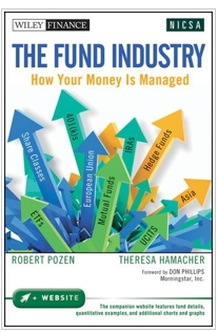Big success is often a matter of science and diligence.
It is possible that people working within the financial services, have no true understanding of how mutual funds work. It is also possible, that many do not understand why mutual funds have become the investment vehicle of choice for investors around the world.
But it is absolutely certain - only a handful of people in the world, grasp the science behind what makes an asset manager win over its competitors.
For that purpose, I want to tell you about a brand new book - The Fund Industry: How Your Money is Managed (Wiley Finance).The book is written by Robert Pozen, Senior Lecturer at Harvard Business School, and Theresa Hamacher, President of NICSA. It is highly appointed, in our industry circles, as the ultimate fund industry companion - a book that will not be surpassed, not until its next edition - by the very same authors.
The great thing about The Fund Industry is that it clarifies a lot of difficult subjects in the mutual fund area. The book is comprehensive and it covers areas such as history and growth of mutual funds, how funds are sold through brokers, banks, insurance agents and the roles of independent directors and boards. It even goes into the challenges of gathering assets internationally, and the limitations of some alternative products.
And because of the power of internet, which has brought our (networked) personalities together, I asked Bob and Theresa to write a short post for our readers. It pertains to the winning formula for US Asset Managers.
Enter BOB POZEN and THERESA HAMACHER, authors of THE FUND INDUSTRY:
The Winning Formula for US Asset Managers
"During the late 1990s through 2001, US asset managers were frequently acquired by outsiders – Europeans and other types of financial firms such as banks, insurers and broker dealers. For example, Unicredito Bank bought Pioneer and Morgan Stanley bought Van Kampen. However, by 2010, most of the outsiders had left the fund management business and the dedicated fund managers were once again ascendant.
Why did industry insiders win out over industry outsiders? Banks , insurers and brokers generally bought asset managers as part of a financial supermarket strategy.
Under that strategy, if the financial firm had customers buying financial product X, it could distribute to those same customers financial products y and z. So it made sense to build an array of affiliated managers who could provide more financial products to the same customer base.
But the financial supermarket strategy was not effective for several reasons. First, and most important, was the move toward open architecture. High net worth customers wanted the best manager of a fund, not an affiliated one. Second, the SEC began to scrutinize much more closely practices like paying special compensation to brokers who sold affiliated funds. Third, some portfolio managers did not like the bureaucratic culture of a large financial institutions; they also wanted to be paid on the basis of the performance of the asset management unit, not the performance of the larger institution.
In 2003-2005, Citigroup and Merrill Lynch both decided to sell their asset management units and to concentrate on distribution of all financial products. These sales in turn reinforced the positions of BlackRock and Legg Mason as asset managers. Between 2007 and 2009, a number of large institutions chose to sell their asset management units in order to raise capital in response to the financial crisis. These included sales by AIG, Bank of America, Lincoln Life and Barclays.
Now the asset management industry is again dominated by two groups of dedicated asset management firms. One is the big private firms – Capital Research, Fidelity and Vanguard – which have continued to top the ranks of mutual fund managers. All three are organized effectively as partnerships, though the technical legal format may vary. The second group is the private-public firms like BlackRock, Franklin and T Rowe Price. While these firms have publicly held shares, they are effectively controlled by their own investment managers.
Thus, the winning formula seems to be clear – a firm primarily dedicated to asset management that either is privately held or controlled by insiders. These firms have the focus on asset management, the long-term perspective and the informal cultures that are critical to success in asset management."
Note: The statistics on all acquisitions and mergers in the asset management industry are detailed in chapter 15 of The Fund Industry: How Your Money is Managed (Wiley Finance). The celebrated book is out today. To become a member of NICSA- visit their website.
It is possible that people working within the financial services, have no true understanding of how mutual funds work. It is also possible, that many do not understand why mutual funds have become the investment vehicle of choice for investors around the world.
But it is absolutely certain - only a handful of people in the world, grasp the science behind what makes an asset manager win over its competitors.
For that purpose, I want to tell you about a brand new book - The Fund Industry: How Your Money is Managed (Wiley Finance).The book is written by Robert Pozen, Senior Lecturer at Harvard Business School, and Theresa Hamacher, President of NICSA. It is highly appointed, in our industry circles, as the ultimate fund industry companion - a book that will not be surpassed, not until its next edition - by the very same authors.
The great thing about The Fund Industry is that it clarifies a lot of difficult subjects in the mutual fund area. The book is comprehensive and it covers areas such as history and growth of mutual funds, how funds are sold through brokers, banks, insurance agents and the roles of independent directors and boards. It even goes into the challenges of gathering assets internationally, and the limitations of some alternative products.
And because of the power of internet, which has brought our (networked) personalities together, I asked Bob and Theresa to write a short post for our readers. It pertains to the winning formula for US Asset Managers.
Enter BOB POZEN and THERESA HAMACHER, authors of THE FUND INDUSTRY:
The Winning Formula for US Asset Managers
"During the late 1990s through 2001, US asset managers were frequently acquired by outsiders – Europeans and other types of financial firms such as banks, insurers and broker dealers. For example, Unicredito Bank bought Pioneer and Morgan Stanley bought Van Kampen. However, by 2010, most of the outsiders had left the fund management business and the dedicated fund managers were once again ascendant.
Why did industry insiders win out over industry outsiders? Banks , insurers and brokers generally bought asset managers as part of a financial supermarket strategy.
Under that strategy, if the financial firm had customers buying financial product X, it could distribute to those same customers financial products y and z. So it made sense to build an array of affiliated managers who could provide more financial products to the same customer base.
But the financial supermarket strategy was not effective for several reasons. First, and most important, was the move toward open architecture. High net worth customers wanted the best manager of a fund, not an affiliated one. Second, the SEC began to scrutinize much more closely practices like paying special compensation to brokers who sold affiliated funds. Third, some portfolio managers did not like the bureaucratic culture of a large financial institutions; they also wanted to be paid on the basis of the performance of the asset management unit, not the performance of the larger institution.
In 2003-2005, Citigroup and Merrill Lynch both decided to sell their asset management units and to concentrate on distribution of all financial products. These sales in turn reinforced the positions of BlackRock and Legg Mason as asset managers. Between 2007 and 2009, a number of large institutions chose to sell their asset management units in order to raise capital in response to the financial crisis. These included sales by AIG, Bank of America, Lincoln Life and Barclays.
Now the asset management industry is again dominated by two groups of dedicated asset management firms. One is the big private firms – Capital Research, Fidelity and Vanguard – which have continued to top the ranks of mutual fund managers. All three are organized effectively as partnerships, though the technical legal format may vary. The second group is the private-public firms like BlackRock, Franklin and T Rowe Price. While these firms have publicly held shares, they are effectively controlled by their own investment managers.
Thus, the winning formula seems to be clear – a firm primarily dedicated to asset management that either is privately held or controlled by insiders. These firms have the focus on asset management, the long-term perspective and the informal cultures that are critical to success in asset management."
Note: The statistics on all acquisitions and mergers in the asset management industry are detailed in chapter 15 of The Fund Industry: How Your Money is Managed (Wiley Finance). The celebrated book is out today. To become a member of NICSA- visit their website.


 RSS Feed
RSS Feed